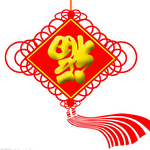This is a man with so many legend; this is an idol who is still been worshipped by Chinese people; this is the warrior Guan Yu (Pinyin: Guān Yǔ) that will never let people down!
-under cinstruction
Reminder: This year's Qixi Festival (七夕节, pinyin: qī xī jié) is: 2010-08-16
In China, the fictional dragon (Pinyin:lóng) and the phoenix (Pinyin: fèng huáng) are traditional animals that symbolize auspiciousness. Along with the kylin and tortoise, they were known as the "Four Supernatural Spirits."
 In ancient China the kite was known as 'Zhiyuan' (paper glede). Originally regarded as a technology, the kite also featured prominently in many art collections, and was considered to have unique artistic value.
In ancient China the kite was known as 'Zhiyuan' (paper glede). Originally regarded as a technology, the kite also featured prominently in many art collections, and was considered to have unique artistic value.
 We have introduced what shadow puppetry is here several months ago. Today we want to show you THE representative branch: Tang Shan Shadow Puppetry.
We have introduced what shadow puppetry is here several months ago. Today we want to show you THE representative branch: Tang Shan Shadow Puppetry.
 "Chinese wax printing is a special Chinese handicraft typical of ethnic characteristics and local styles. As one of the most antique handworks, it is perceived as an important part of China's ancient civilization. Qin (221-206BC) and Han (206BC-AD220) dynasties and prevailing in the Sui (581-618) and Tang dynasties (618-907), wax printing, which been passed down from one generation to the next in China, is a uniquely inspired drawing and dyeing handwork of the Miao ethnic minority.
"Chinese wax printing is a special Chinese handicraft typical of ethnic characteristics and local styles. As one of the most antique handworks, it is perceived as an important part of China's ancient civilization. Qin (221-206BC) and Han (206BC-AD220) dynasties and prevailing in the Sui (581-618) and Tang dynasties (618-907), wax printing, which been passed down from one generation to the next in China, is a uniquely inspired drawing and dyeing handwork of the Miao ethnic minority. Grand Opening! We would like to invite you to join us to witness how China Tradition Shop starts from ZERO with your help and appreciation. Discounts and Surprises inside! Check us out! Items will be updated soon...
 China Tradition Shop
China Tradition Shop
 Less Pain Chinese
Less Pain Chinese
Copyright © 2009 - China Tradition Shop - is proudly powered by Blogger
Smashing Magazine - Design Disease - Blog and Web - Dilectio Blogger Template